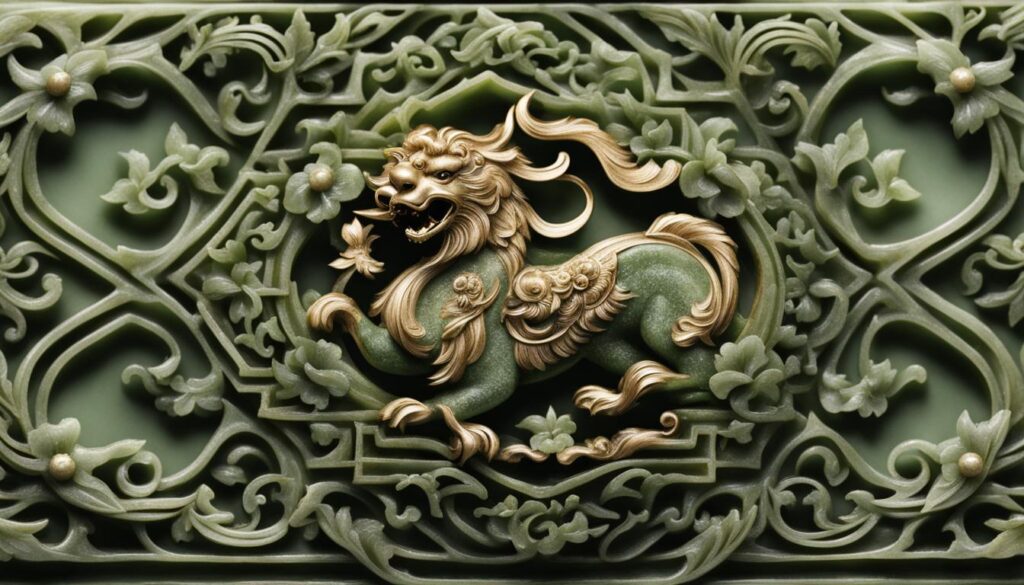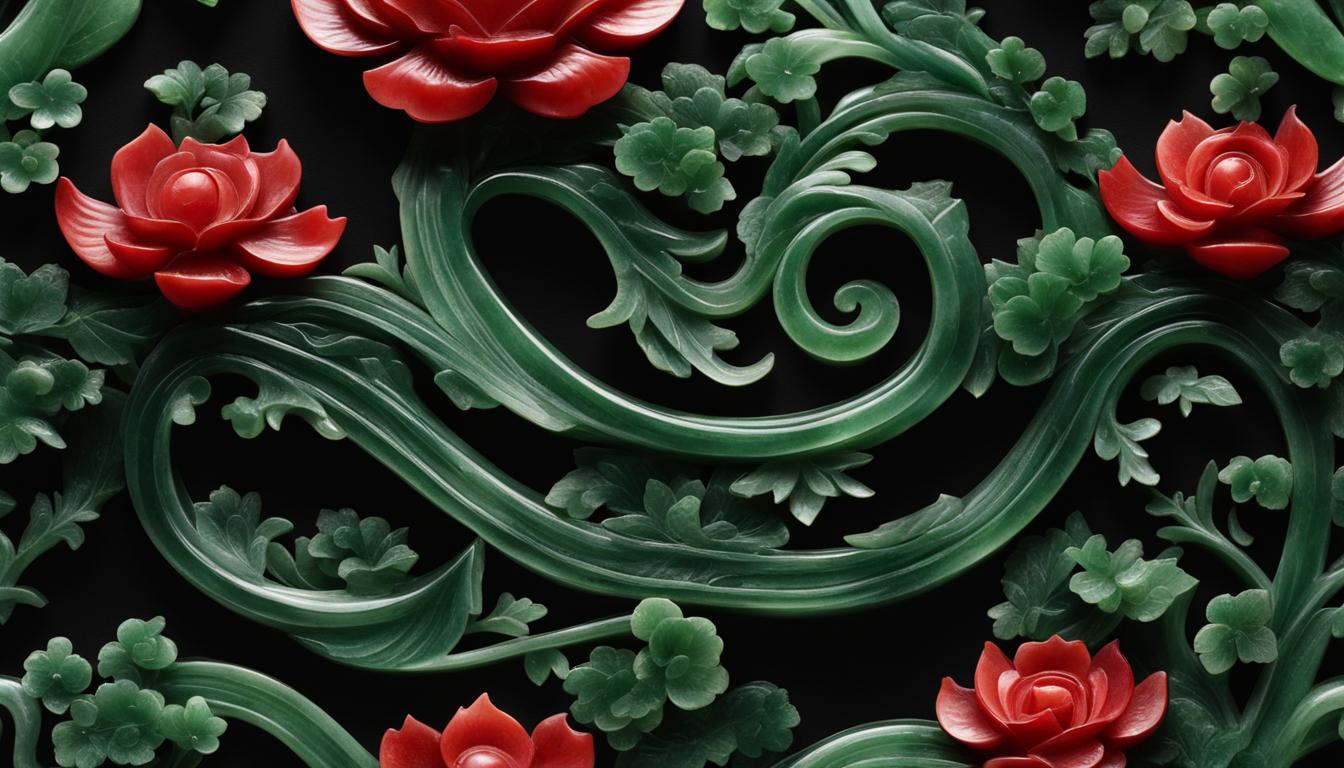Welcome to a world of beauty and craftsmanship that spans thousands of years – the captivating realm of Chinese jade carvings. These exquisite creations are not only rare and valuable but also an embodiment of traditional Chinese art and culture. Each piece tells a story, reflecting the rich history and philosophy of the Chinese civilization.
When it comes to authentic jade carvings, collectors seek out those that showcase traditional techniques passed down through generations. These intricately designed pieces are a testament to the skill and dedication of the artisans who bring them to life.
From ancient times to the present day, Chinese jade carvings have fascinated art enthusiasts around the world. Their allure lies in their remarkable beauty, meticulous craftsmanship, and profound cultural symbolism.
Key Takeaways:
- Chinese jade carvings are highly esteemed and valued by collectors.
- Authentic jade carvings showcase traditional techniques.
- These exquisite pieces reflect the rich history and philosophy of Chinese culture.
- Jade carvings are intricately designed and meticulously crafted.
- They hold deep cultural and symbolic meanings.
The History and Evolution of Chinese Jade Carvings

Chinese jade carving has a remarkable history that spans over 5,000 years. This ancient art form has witnessed five significant periods of development, influenced by political, economic, and cultural factors. During these epochs, jade carvings held immense value and were cherished for their functionality and ceremonial significance.
The craftsmanship and artistry of handcrafted jade carvings from ancient China continue to captivate collectors to this day. These masterpieces showcase the skill and precision of ancient artisans, with each carving reflecting the rich cultural heritage and exquisite aesthetics of traditional Chinese craftsmanship.
“The history of Chinese jade carvings is a testament to the enduring legacy of this art form. From delicate figurines to intricate jewelry, every piece tells a story of ancient Chinese culture and craftsmanship.” – Collector, Sarah Thompson
The Peaks of Development
Chinese jade carving has experienced five major peaks of development, each characterized by distinct styles and techniques. These peaks mark significant periods in history when jade carvings were particularly valued and sought after. Let’s explore these peak periods:
- The Neolithic Period (c. 5000 BCE – 1700 BCE): During this time, jade carvings primarily served as objects of religious and spiritual significance. They were often used in burial rituals and were believed to grant protection and immortality to the deceased.
- The Shang Dynasty (c. 1600 BCE – 1046 BCE): Jade carvings reached new heights during the Shang Dynasty. They were intricately carved into various shapes, such as weapons, ritual objects, and ornaments. These carvings symbolized power, authority, and the divine.
- The Zhou Dynasty (1046 BCE – 256 BCE): Jade carvings from the Zhou Dynasty were characterized by their symbolic and auspicious motifs. They were believed to bring good fortune, prosperity, and spiritual blessings to those who possessed them.
- The Han Dynasty (206 BCE – 220 CE): Jade carvings during the Han Dynasty featured intricate designs and exquisite craftsmanship. They were highly valued by the ruling elite and were considered symbols of wealth, social status, and nobility.
- The Ming and Qing Dynasties (1368 CE – 1912 CE): The Ming and Qing Dynasties witnessed a resurgence in jade carving. Fine details, intricate patterns, and innovative designs were hallmarks of jade carvings from this period. Jade objects became highly coveted collectibles.
| Period | Key Characteristics |
|---|---|
| The Neolithic Period | Objects of religious significance, burial rituals |
| The Shang Dynasty | Symbolic carvings, power, and authority |
| The Zhou Dynasty | Auspicious motifs, good fortune |
| The Han Dynasty | Craftsmanship, wealth, and social status |
| The Ming and Qing Dynasties | Fine details, innovative designs, collectibles |
Jade Carving Tools and Techniques
The art of Chinese jade carving has evolved over centuries, driven by advancements in tools and techniques. From primitive tools to modern machinery, these innovations have allowed craftsmen to create high-quality and collectible jade carvings that showcase the traditional beauty of Chinese culture.
Throughout history, different generations of tools have been used in jade carving. Originally, craftsmen relied on primitive rotary machines, which required manual labor and were limited in precision. However, as technology advanced, motor-powered machines were introduced, enabling more intricate and detailed carvings to be achieved.
One of the key techniques that have been utilized in the carving of high-quality jade pieces is piercing. This technique involves delicately drilling holes through the jade, creating intricate patterns and designs. By using piercing, craftsmen can achieve a level of intricacy that adds to the allure of collectible jade carvings.
Another traditional technique that is still employed today is Qiaose, which involves carving jade into thin layers and then reassembling them to form intricate patterns. This technique requires exceptional skill and precision to ensure that the layers fit together seamlessly, resulting in a visually stunning piece of art.
With the combination of advanced tools and traditional techniques, craftsmen can create high-quality, collectible jade carvings that embody the beauty and cultural significance of traditional Chinese jade carvings.
| Advancements in Jade Carving Tools | Techniques Used in Jade Carvings |
|---|---|
| Primitive rotary machines | Piercing |
| Motor-powered machines | Qiaose |
Symbolism and Meaning in Chinese Jade Carvings
Chinese jade carvings are not only exquisite pieces of art but also repositories of deep cultural and spiritual symbolism. These carvings often feature intricate designs and motifs that hold significant meaning in Chinese culture.
Animals, plants, and mythical creatures are commonly depicted in ancient Chinese jade carvings, each representing various virtues and aspects of Chinese society. For example, the dragon symbolizes power, strength, and good fortune, while the phoenix represents grace, beauty, and prosperity. These symbolic representations not only add aesthetic appeal to the carvings but also capture the essence of Chinese values and beliefs.
“Jade has a brighter luster when worn by someone virtuous.”
The cultural significance of jade carvings extends beyond mere ornamentation. In ancient times, jade carvings were used in burial practices to protect and ensure the immortality of the deceased. These carvings were believed to possess spiritual qualities and were placed in the tombs as a talisman for the journey into the afterlife.
The value of ancient Chinese jade carvings lies not only in their exquisite craftsmanship but also in the deep symbolism and meaning they embody. Collectors and enthusiasts are drawn to these valuable pieces, not just for their beauty but also for the cultural and spiritual legacy they represent.
Conclusion
Chinese jade carvings are more than just exquisite pieces of art; they are a testament to the rich history, craftsmanship, and symbolism of Chinese culture. From ancient carvings dating back thousands of years to modern creations, these jade carvings continue to captivate collectors with their beauty and cultural significance.
What sets authentic and traditional Chinese jade carvings apart is their rarity and artistic excellence. Collectors value them for their craftsmanship and the adherence to traditional techniques that have been passed down through generations. Each piece of jade is meticulously handcrafted, showcasing the skill and expertise of the artisans.
As the appreciation for Chinese jade carvings grows, so does their cultural value. With intricate designs and symbolic motifs, these carvings not only reflect the beauty of nature but also convey deep meaning. Whether it is an ancient carving representing strength and prosperity or a modern piece depicting harmony and balance, Chinese jade carvings have an enduring appeal that transcends time.
In the world of art collecting, Chinese jade carvings stand out as unique and coveted treasures. Their exquisite beauty, coupled with their cultural significance, makes them highly sought after by collectors around the globe. As we continue to delve into the fascinating world of Chinese jade carvings, we can expect to see an even greater appreciation for their craftsmanship and a surge in creative designs that push the boundaries of this ancient art form.
FAQ
Why are Chinese jade carvings considered rare and valuable?
What is the history behind Chinese jade carvings?
What techniques are used in the carving of Chinese jade carvings?
What kind of symbolism and meaning do Chinese jade carvings incorporate?
Why are ancient Chinese jade carvings highly valued?
Source Links
- https://www.marklawsonantiques.com/chinese-jade-prized-gemstone-of-imperial-china/
- https://www.gia.edu/gems-gemology/spring-2020-chinese-jade-carving-evolution
- https://www.sothebys.com/en/digital-catalogues/junkunc-chinese-jade-carvings

